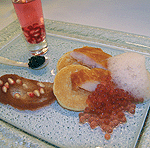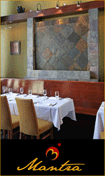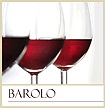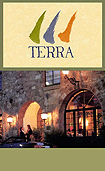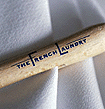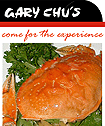| Pomegranate
Trio: “Caviar, Air and Paste."
(Smoked Sturgeon, Potato
Blini, Pomegranate Vodka with Beluga Caviar)
By Assistant
Executive Chef -- Fine Dining, Chef Kurtess Mortensen, Paris
and Bally's Las Vegas, NV
For
4 Servings
Ingredients:
8 Small Potato Blinis (recipe follows)
200g Thinly Shaved Smoked Sturgeon
100g Pomegranate "Caviar" (recipe follows)
Four Spoonfuls of Pomegranate "Air" (recipe follows)
40g Pomegranate Paste (recipe follows)
4 Shots Van Gogh Pomegranate Vodka
60g Cleaned Pomegranate Seeds
20g Beluga Caviar
Note:
Most of these recipes have been developed using the products
distributed by Chef Ferran Adria of El Bulli in Spain. The
chemicals listed below are available from El Bulli under
the label of the all natural “Texturas" line
of products. To understand the all natural line of “Texturasî"
products and how chefs use them, go to www.texturaselbulli.com/ENG_AFA/index.html
Blini
Ingredients:
4 Large Yukon Gold Potatoes
100g All Purpose Flour
3 Large Eggs
75g Crème Fraiche
Salt and White Pepper
Procedure:
1. Boil the potatoes in their skins. When
a knife can just be inserted into the potato without feeling
resistance they are cooked. While they are still hot, peel
of the skins and pass through a ricer. Weigh out 400g of
the potato product and place in a food processor. Pulse
in the flour, and then add the eggs one at a time. Add the
crËme fraiche a little at a time until the consistency
resembles thick pancake batter. Season the batter to taste
with salt and white pepper. The batter can be held warm
for an hour, do not let it cool.
2.
Brush a nonstick griddle warmed to 300F with clarified butter.
Drop the batter in even tablespoon sized dollops onto the
surface and cook for 3-4 minutes on the first side followed
by 1-2 minutes on the second. Hold the blini on a warm nonstick
sheet for a few minutes until ready to serve.
Caviar
Ingredients:
250g Pomegranate Juice
4g Algin
500g Bottled Flat Water
4g Calcic
Procedure:
Mix the Algin with 1/3 of the pomegranate juice and blend,
then mix in the rest. Separately, dissolve the Calcic in
the water. Fill 4 syringes with the Algin/Pomegranate mixture.
Expel it drop by drop into the Calcic base. Remove after
1 minute, strain and rinse the resulting caviar in cold
water. Reserve in a clean container to be spooned on later.
Notes
from Chef Kurtess:
Algin and Calcic are "Texturas" branded names
for two all natural chemicals used in the spherification
process. †Algin is a very refined and useable form
of Sodium
Alginate. Calcic is the equivalent product of Calcium Chloride.
Both are water soluble and when they are dissolved and combined
they react to form a membrane between the two substances.
What
is ALGIN?
A natural product extracted from brown algae (of Laminaria,
Fucus, and Macrocystis genera, among others) that grow in
cold water regions of Ireland, Scotland, North and South
America, Australia, New Zealand, South Africa, etc. Depending
on the part of the algae that has been refined, the texture
and Calcic reactivity of each alginate varies. For this
reason, we have selected Algin as the ideal product for
achieving spherification with guaranteed results
Characteristics:
Presented in a refined powder. Gels in the presence of Calcic.
Dilutes while cold with strong agitation. It need not be
heated to produce spherification.
What
is CALCIC?
This product is a calcium salt traditionally used in the
food industry, for example in cheese making. Calcic is essential
in the reaction with Algin that produces spherification.
It is the ideal reactant for its high water solubility,
considerable calcium content, and consequently great capacity
for producing spherification.
Characteristics:
Presented in granules. Highly water soluble. Great moisture
absorption capacity
Air
Ingredients:
250g Pomegranate Juice
10g Soy Lecithin (Lecite)
Procedure:
Mix 1/3 of the juice together with the lecite with a hand
blender until dissolved. Blend in the remaining juice. Hold
until just before use. Using a hand powered cappuccino foamer,
blend the juice near the surface to create foam. Continue
for a couple of minutes until several spoonfuls of the foam
"air" sit on top of the surface of the liquid.
Let sit for a minute or so to stabilize, then spoon off
directly onto the plate. This product will not hold for
long.
What
is Lecite?
Lecithin can be derived, and is available, from a number
of sources, soy lecithin being the most common and best
priced. †It is also user friendly. I like the very
refined Lecite product also distributed in the Texturas
line.
A
natural soy lecithin-based emulsifier, ideal for making
airs. It is useful in the prevention of arteriosclerosis
and contains vitamins, minerals and antioxidants.
Lecite is made from non-transgenic soy.
Characteristics:
Presented in a refined powder. Cold soluble. Very soluble
in aqueous mediums. Thanks to its great emulsifying power,
Lecite is the ideal product for converting juices and other
watery liquids into airs. It also has a surprising capacity
to emulsify impossible sauces.
Paste
Ingredients:
250g Pomegrante Juice
30g Granulated Sugar
10g Red Wine Vinegar
6 g Agar Agar
Procedure:
1. Bring the juice to a simmer with the
sugar and vinegar. Add the Agar and blend in with a hand
blender, return to a simmer. Pass through a chinoise into
a pan to set. This will gell in the cooler.
2.
When time comes to serve, blend the gel in a food processor
or with a hand blender until the consistency resembles a
thick sauce. Press onto the plate with a spoon.
What
is Agar?
Extracted from a type of red algae (of the Gelidium and
Gracilaria genera), AGAR is a gelling agent used in Japan
since the 15th century. In 1859, it was introduced to Europe
as a characteristically Chinese food, and at the start of
the 20th century it began to be used in the food industry.
It is a source of fiber and can form gels in very small
proportions. It can be used to make hot gelatins.
Characteristics:
Presented in a refined powder. Mix while cold and bring
to a boil. Gelification is fast. Once gelled, it can withstand
temperatures of up to 80 ∞C (hot gelatin). Allow it
to rest for correct gelification. In acidic mediums, it
loses part of its gelling capacity.
To
Assemble the Dish:
Place two warm blinis onto each plate. Arrange 50g of smoked
sturgeon on and around the blini. Place a spoonful of caviar
onto the sturgeon and a spoonful of air along side. Spoon
a tablespoon of the paste onto empty space on the plate
and drag the spoon through it to create a "comma"
shape. Fill four shot glasses with the vodka and drop in
a few pomegranate seeds then sit the glasses on an empty
part of the plate. Place 5g of the beluga caviar onto a
caviar spoon; rest it across the top of the shot glass.
To
Eat:
Enjoy the sturgeon and blinis with the three different flavors
and textures of the same ingredient. Afterward, enjoy the
vodka with the caviar, appreciating the textural similarities
of genuine caviar and the imitation pomegranate version.
Or, any way you like as long as you enjoy it!
Note:
Measures are in metric.
For measurement conversion tables click
here.

Bally's Las Vegas
3645 Las Vegas Blvd.
South Las Vegas, NV 89109
Office : 702.946.4476
www.harrahs.com
Other
Related Links:
Armenian
Pomegranate Wine, Vodka and Liqueur
By George Brozowski
Pomegranate
History and Folklore
By Shaheen Perveen
|



